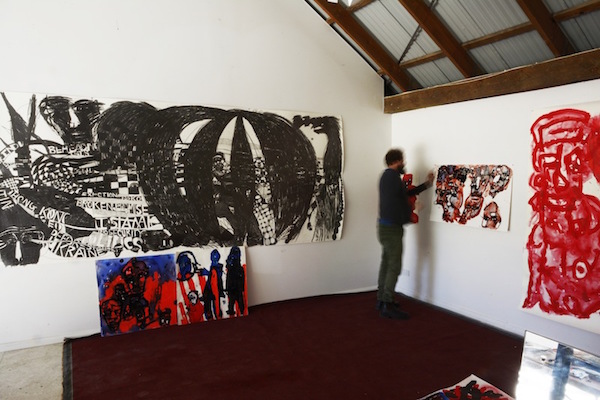
Locust Jones Studio. Photo by Damian Dillon. Courtesy Locust Jones and Karen Woodbury Gallery, Melbourne
Unafraid to embrace social commentary within his work, New Zealand-born artist Locust Jones creates thought-provoking pictorial compositions influenced by mass media. In a process of appropriation and re-interpretation, Jones weaves a web of images and text derived from newspaper clippings, the internet, television and radio.
This spontaneous process results in organic hand-drawn imagery that can be understood as an ongoing newspaper about the world. From anonymous faces and weapons of war, to skyscrapers and aeroplanes, Jones presents an apocalyptic and tragic worldview for audiences to reflect upon. In the midst of his current solo exhibition Brainfog at Karen Woodbury Gallery in Melbourne, Jones discusses his concept for the show with Rachael Vance, sharing insights into his working process and the perceived “media fog” in which we exist.

Locust Jones Studio. Photo by Elger Esser. Courtesy Locust Jones and Karen Woodbury Gallery, Melbourne
What was your motivation behind this exhibition?
The selection of works is the result of a continuity of process, from days spent in the studio, listening and reading about world events, processing information and interpreting that into drawings and lithographs.
Can you see a departure from your earlier work?
In the past I literally transcribed images of interest onto the paper, but now my drawings are more like interpretations of the information gathering process. Imagery is also infused with personal narratives and events. For instance, in this exhibition there is a suite of lithographic portraits of my recently deceased father.

Locust Jones, A week in the life of the world 30 Jan – 5 February 2015, 2015, ink on paper, 94.3 x 133.8 cm (framed). Image courtesy the artist and Karen Woodbury Gallery, Melbourne
Why are you drawn to catastrophe and destruction in the news?
It’s a recording of information and events that I read about and feel strongly about. The act of recording is more about remembering and critiquing the mechanisms of the media rather than presenting injustices. It is perhaps more about our access to information, its construction and the speed of what we see and hear.
We are bombarded with so much information every day that we forget what happened yesterday. I hope to convey a reawakening of sorts to viewers and reveal certain processes: my personal process, the process of making art and the process of news information.
Can you explain one of the most recent works in the show, Self Report? I notice you use a blood red colour, moving away from the inky blue that has become synonymous with your work.
The image depicts a United Nations security council meeting with representatives from different countries discussing issues in the Middle East. This is the first time I projected an image onto the surface of the paper to get a rough outline. While the black ink was drying I emptied a litre of red ink on top. The thick red ink highlights the fact that events discussed in the safety of a meeting room have huge ramifications for people on the ground.

Locust Jones, Self Report, 2015, ink on paper, 79.8 x 114.8 cm (framed). Image courtesy the artist and Karen Woodbury Gallery, Melbourne
You use a range of beautiful inks and specialised papers. What is your preferred choice of medium and materials?
I use a variety of papers and techniques. I tend to favour tough paper with a high GSM and I like German and French shellac-based inks. I rarely use brushes and usually draw with lengths of bamboo I cut from the garden. I work quickly and it’s quite a physical and messy process. Lately I have been working with graphite powder, laying it down on the surface of the paper and working it in with my fingers.
You have a suite of scroll works in the show that reflect your spontaneous working process. How do you create these them?
I work from right to left on some scrolls, and left to right on others. I lay out photographs on the surface of the paper that interest me and pin them to the walls of the studio so I am surrounded by images. I also listen to the radio or have Al Jazeera streaming live at the same time. I am in a zone of media saturation when I work. The piece is finished when I get to the end of the roll.

Locust Jones, Brainfog (detail), 2014, ink, watercolour on Korean mulberry paper, 110.0 x 1093.0 cm. Image courtesy the artist and Karen Woodbury Gallery, Melbourne
Recently you have been working on a range of local and international exhibitions. Take me through them.
I work every day and this is an important part of my practice. Each show is made up of works I have produced, edited into an interesting and meaningful exhibition. At the end of last year I held a solo exhibition A descent into the mass media maelström at Galerie Patrick Ebensperger in Berlin followed by Burn Freeze at David Krut Projects in New York. After my current exhibition at Karen Woodbury Gallery in Melbourne, I am working towards a solo exhibition with Dominik Mersch Gallery in Sydney, followed by an exhibition at the Blue Mountains Cultural Centre in Katoomba.
Locust Jones: Brainfrog, Tues to Sat 11am-5pm until 23 May 2015, Karen Woodbury Gallery, Melbourne, Level 1/167 Flinders Lane, Melbourne; (03) 96395855, karenwoodburygallery.com
